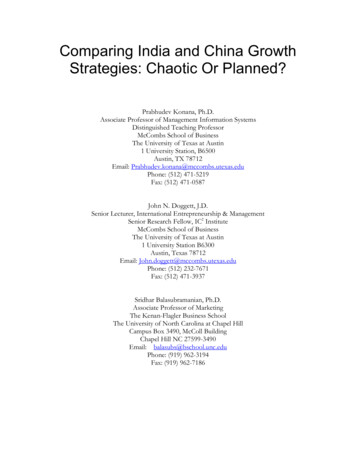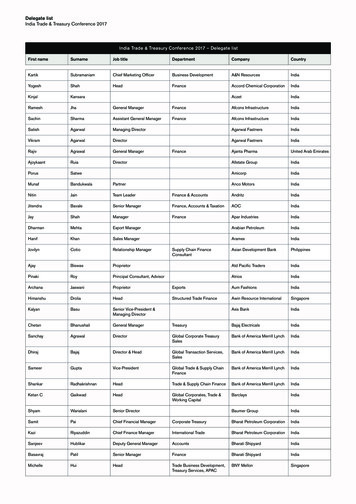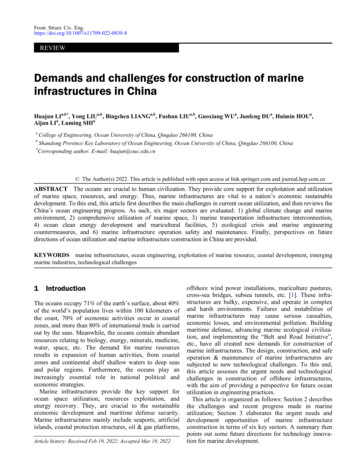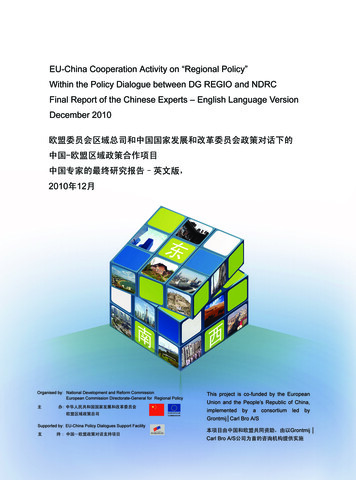
Transcription
Comparing India and China GrowthStrategies: Chaotic Or Planned?Prabhudev Konana, Ph.D.Associate Professor of Management Information SystemsDistinguished Teaching ProfessorMcCombs School of BusinessThe University of Texas at Austin1 University Station, B6500Austin, TX 78712Email: Prabhudev.konana@mccombs.utexas.eduPhone: (512) 471-5219Fax: (512) 471-0587John N. Doggett, J.D.Senior Lecturer, International Entrepreneurship & ManagementSenior Research Fellow, IC2 InstituteMcCombs School of BusinessThe University of Texas at Austin1 University Station B6300Austin, Texas 78712Email: John.doggett@mccombs.utexas.eduPhone: (512) 232-7671Fax: (512) 471-3937Sridhar Balasubramanian, Ph.D.Associate Professor of MarketingThe Kenan-Flagler Business SchoolThe University of North Carolina at Chapel HillCampus Box 3490, McColl BuildingChapel Hill NC 27599-3490Email: balasubs@bschool.unc.eduPhone: (919) 962-3194Fax: (919) 962-7186
Comparing India and China Growth Strategies:Chaotic Or Planned?IntroductionDespite different political systems, China and India are aggressively pursuing economic liberalizationfor growth. Both the countries tout science and technology, and exports as a basis for their growth.Yet, their strategic paths for economic development are remarkably different. China’s strategy ismethodical and deliberate, while that of India’s is chaotic and opportunistic. This article comparesthe growth strategies of China and India since they will impact a third of humankind by 2050,influence world-wide job migration, and provide valuable lessons for other developing countries.China is marching ahead with over 10% gross domestic product (GDP) growth rates overthe last two decades. China has followed a conventional path in transiting from an agriculturaleconomy to a robust industrial economy – an evolution observed in many developed countriesincluding the U.S., Japan, South Korea and Taiwan. China is building vital linkages among itsagricultural, industrial and service sectors, and systematically encouraging domestic consumption inparallel with a sharp focus on exports. Guided by the firm hand of the government, China’sapproach to development has been methodical and deliberate. The results may be far from perfect.The urban-rural economic divide and the impact on the environment may be worsening. On thepositive side, though, China’s per capita GDP is now double that of India, although both nationshad similar numbers as late as 1991.In contrast, India is attempting to leapfrog from a predominantly agricultural economy to aknowledge-based service economy. This approach is highlighted as the “shining” beacon of a 21stcentury economic development model. Bureaucrats and business leaders cite India’s 6% GDPCopyright Konana, Doggett and Balasubramanian 20041
growth over the last decade and the strong growth of India’s software and IT-enabled services(SITS, henceforth) sector in support of the leapfrogging approach. However, they ignore the lack ofvital linkages of SITS with the remainder of the Indian economy and the fact that less than 10% ofthe GDP growth is actually due to the SITS sector. Linkages with other economic sectors areessential since they exert a ripple or multiplier effect and create large numbers of jobs for the entirespectrum of workforce. The SITS sector employs mainly the educated, urban youth, leaving a largefraction of the India’s population further behind. If a country is to pursue a politically andeconomically stable development strategy in largely rural, unskilled agricultural economy it mustfocus on such linkages.Some have argued that focusing on building a “knowledge economy” will power India aheadof China. However, there is little evidence that short term gains from SITS can be translated intolong term sustainable advantages. In fact, despite a robust GDP growth that exceeded 8%, theBharatiya Janata Party that had overseen the economic policies of the government in the recent pastwas voted out of power in May 2004. The party’s “India Shining” slogan was rejected by adisaffected electorate that had seen limited improvement in their daily living conditions.Contrast this with the confidence the world has placed on China in awarding her theOlympics in 2008 and the World Trade Fair in 2010. China has demonstrated that it has the will andthe resources to host the Olympics, which calls for a massive infusion of resources to create a firstworld infrastructure. The public and private sector investments in China towards preparing for theOlympics are expected to touch 180 billion by 2008. The impact of infrastructure developmentprojects for the Olympics will be significant: jobs for millions of low income and low skilledworkers. Further, hosting the Olympics will help enhance the nation’s psyche and its confidence.China is also using the Olympics to prepare its inefficient state owned enterprises (SOE) to competeCopyright Konana, Doggett and Balasubramanian 20042
in the global economy. Such a significant physical and psychological transformation is much neededin the Indian context if India is to compete effectively in the global economy.China’s success is highlighted by another interesting statistic. Research findings suggest thata country’s performance in the Olympic Games depends not just on its population, but also on percapita gross domestic product (GDP).1 China’s recent 63 (32 gold, 17 silver and 14 bronze) medals –third highest total tally after US and Russia – at the 2004 Olympics in Athens suggest the growingeconomic progress and confidence. In contrast, India won one silver medal at the Olympics.A study by Goldman Sachs suggests that India will be the third largest economy by 2032behind the U.S. and China.2 However, the real measure of economic well-being is per capita GDP.Consider this – while China’s per capita GDP exceeds that of India by 550 today – that gap isexpected to increase to a substantial 13,991 by 2050!So, why is India falling behind? Why can the SITS sector not resolve India’s sharp disparitiesin wealth and widespread poverty? And what can India and other developing economies learn fromthis situation? A deeper look at the growth paths of the Indian and Chinese economies providessome insights in this context.India’s SITS Sector: Planned or Accidental?While China’s growth is primarily the result of specific policies targeting manufacturing activities,India’s growth in the SITS sector in 1990s has been primarily accidental and reflects the hard workof few companies and individuals. The growth is attributable to enormous demand from the U.S.and other developed countries due to three generations of IT innovation – client-server, Internet1A. B. Bernard and M. R. Busse, “Who wins the Olympic Games: Economic Resources and Medal Totals,” To appearin Review of Economics and Statistics.2 BRIC Report, Roopa Purushothaman and Dominique Phillips, Goldman Sachs 2003.Copyright Konana, Doggett and Balasubramanian 20043
and the World-Wide Web (WWW), and wireless communication revolution – within a decadeleading to fundamental changes in computing and business practices. The Year 2000 (Y2K) problemalso hung over businesses like a specter through the 1990s, and regulations forced numerous sectorsto recode legacy computer systems to ensure Y2K compliance.During the 1990s software programmers with expertise in enterprise software programmingwere hired at 100 - 150 per hour, with some consulting firms charging clients as much as 300 perhour. Faced with a shortage of skilled labor, U.S. firms lobbied the government to increase thenumber of work visas for foreign talent under the H1-B program. The annual number of visasavailable under this program, which allows foreign citizens to work in the U.S. for six years,temporarily increased from 65,000 to 115,000 for 1999 and 2000, and to 195,000 for 2001-2003.This demand for information and software services provided the opportunity for Indiansoftware companies to showcase their skilled and relatively cheap workforce. The offsite softwaredevelopment model of Indian IT companies grew rapidly as coordination costs – due to global ITinfrastructure like the Internet and learning experience – fell rapidly. U.S. firms also realized thatnot only software services could be obtained from Indian firms, but also any information-relatedbusiness processes (i.e., IT-enabled services) could be offshored to India to benefit from lower costsand large English-speaking workforce. Thus, any strategy to build SITS was more opportunistic anda result of bandwagon effect than a planned strategy. In fact, Indian firms can be lauded for theirsuccess to take advantage of the opportunities, but their “opportunistic success” should not bedeified into being a conscious national strategy.The proponents of India’s SITS-led strategy highlight some impressive data to championtheir vision of India’s economic development led by the SITS sector. For example, India’s SITSsector exported services worth 12.5 billion in 2003-2004, and that figure is projected to grow byCopyright Konana, Doggett and Balasubramanian 20044
25% over the next year.3 Some have argued that SITS-related initiatives in India have invigoratedthe economy as a whole and contributed to its recent growth rate of 6%. Surprisingly, India achievedsimilar growth in 1980s without the SITS sector being a significant factor! While creation of 800,000jobs in SITS sector is impressive, it is insignificant in an economy with 470 million workforce. Incontrast, China has created over 40 million jobs exporting physical products from footwear tounderwear, and hardware and software.The SITS Sector and India’s Economic DevelopmentWhile India rides the SITS wave, the growth is chaotic with relatively insignificant domestic linkagesand consumption. The argument that the SITS sector can serve as the backbone for India’sresurgence on the global economic front is weak. India lags in creating the infrastructure to sustainand grow economic activities. First world infrastructure – located within the four walls of someleading companies – is not visible in any significant part of any city in India, let alone an entire cityor region. Little attention is paid to create jobs for masses, or to formulate policies that touch themasses for sustained development.A strategy that relies on the movement of white-collar jobs from developed nations to Indiais difficult to sustain. Many of these jobs, especially those related to business process outsourcing(e.g., call center jobs) create little or no intellectual property for Indian firms. With few barriers toenter or exit, these jobs will shift to other countries for the same reasons they moved to India. Infact, China is potentially the key competitor in this context. China has begun educating its studentsto speak English in large numbers. As Naren Patni, CEO of Patni computer Systems – the sixthlargest software firm in India – noted in a recent interview “I hear China is holding English classes in3Source: India’s National Association of Software and Service Companies (NASSCOM).Copyright Konana, Doggett and Balasubramanian 20045
stadiums.”4 The case for sustainability is only marginally stronger in the software development sector,where tacit and explicit knowledge regarding software design and processes, can provide somesustainable competitive advantage.The SITS sector does not have strong linkages to the remainder of the Indian economy.Apart from skilled labor, the key inputs such as computers and software (e.g., database managementsystem, operating system, development tools) are all imported. The absence of a well-developedinfrastructure, including power and transportation, makes it difficult to compete globally in thehardware sector. For example, Dell Inc. decided against establishing a manufacturing facility in Indiasince the infrastructure does not allow “just-in-just-out” – inputs arrive just in time and finishedgoods shipped immediately – production model. For SITS, however, there is little need for forwardlinkages such as physical transportation systems since the services are largely provided overelectronic communication networks to foreign clients. Further, since 85% of the output in the SITSsector is currently exported, there is little internal consumption of its output. As a result, the rippleeffects of this sector on the overall economy are severely limited.There are few opportunities in the SITS sector for the unskilled and semi-skilled labor thatconstitute the bulk of India’s poverty-stricken sections of society. While some of this labor could beengaged in construction and maintenance of physical infrastructure related to the SITS sector,including buildings and cable connections, the fraction of labor so absorbed is likely to be low.There are, of course, some indirect benefits. For example, SITS sector employees who drawrelatively high salaries could engage in spending that leads to indirect employment for such labor.Likewise, this sector could enhance travel-related economic activities involving hotels, restaurants,transportation, and shopping. Placing all this in context, though, it is not clear how a sector that4David Kirkpatrick, Outsourcing could get the better of India too, Fortune 16, 2004Copyright Konana, Doggett and Balasubramanian 20046
comprises 3.2% of the GDP can yield significant trickle down effects, even if the sector grows at astrong rate for the next decade.The growth of the SITS sector is likely to exacerbate regional imbalances within India.Almost without exception, this sector is based in the urban, more developed parts of the nation andtargets the well-educated work force. Efforts to geographically diversify this sector have failed. Forinstance, efforts to set up a software park in Hubli, the second largest city in the state of Karnataka –home of IT giants like Infosys and Wipro which are based in the state capital of Bangalore – havenot been successful. Software industry targets an educated workforce who value quality of life andbasic amenities that are absent in cities like Hubli.Finally, there is the question of whether the SITS sector offers the most productivedeployment of skilled human resources at the national level. Many of the call center and back officeworkers in India are over qualified for their jobs. College graduates, chartered accountants, MBAsand engineers are at work answering customer questions during odd hours – the same jobs are heldby high school graduates in the West. Although these jobs pay relatively high wages and provideemployment opportunities for new graduates, the opportunity costs of such employment from asocietal viewpoint may be high. There is evidence that annual churn rate is reaching 40-50% for callcenter jobs. There is increased dissatisfaction with the type of work, and there is no clear path forpersonal development that matches the qualifications of the workers. These skilled employees maycontribute more strongly to economic development in a broad sense if they were encouraged to beentrepreneurs or focused their energies on the infrastructure and core manufacturing sectors.In summary, it is doubtful whether the SITS sector will serve as a platform for India’seconomic development. While Indian software firms must be lauded for taking advantage of theglobal opportunities related to information technology, it is not clear that such corporate success willCopyright Konana, Doggett and Balasubramanian 20047
translate into robust and balanced growth at the national level. In this context, China’smanufacturing sector offers a striking contrast to the SITS sector in India.The Path of ChinaIn contrast with India’s SITS strategy, China’s manufacturing-led strategy is less problematic. “Madein China” is as ubiquitous as air in the global economy. China engaged in over 850 billion worthimports and exports in 2003, almost 10 times the trade volume of India. Even though 60% of thepopulation still lives in poverty-rich western China, anyone who has stepped into China will admitthe existence of First world, state-of-art, infrastructure and living standards in many parts of theeastern coastal belt. China has a planned approach to develop interior areas gradually through largeindustrial parks and infrastructure for movement of physical goods.Recent trade numbers best reflect China’s manufacturing-based economic power. Over 1trillion worth of manufacturing output has moved from Japan to China, with companies likeToshiba shifting the bulk of their manufacturing to mainland China. Curiously, 60% of all IT andelectronics goods from Taiwan, considered a renegade province by Beijing, are actually made inChina. In the fast growing LCD panel market, China produces 60% of the world’s output.The massive influx of manufacturing activities into China has resulted in more than 2.1billion sq. m. of new building construction, an increase of 133% from 1995. China now consumes36% and 50% of the world’s steel and cement production, respectively. The economic activitydriven by manufacturing has led to a substantial service sector and a corresponding increase in newjobs, travel, and tourism. The increase in disposable income is reflected in the 75% growth in carsales in 2003, coupled with a dramatic increase in spending on consumer goods. China today hasCopyright Konana, Doggett and Balasubramanian 20048
nearly 300 million cell phones, almost 8 times the number in India. Despite its large population,China’s per capita GDP has doubled in the last decade and grown 500% since 1980.How did China grow this rapidly? There are two key reasons: Foreign Direct Investments(FDI), and the domestic – backward and forward – linkages. China’s growth through FDI, whichnow stands at 52 billion as opposed to 4 billion for India, has been discussed extensively. Thepolicy shift to grow out of FDI is well summarized by Deng Xiaoping that “it doesn't matter if the cat isblack or white, the important thing is that it can catch mice.” The idea is simple – if growth and well-being ofthe people can come from attracting FDI and exporting, so be it. The second driver of this growthis China’s ability to build successful backward and forward linkages between manufacturing activityand the rest of its economy. Such linkages, to an extent, are more naturally associated withmanufacturing than with software and information services.China’s strategy of attracting FDI can be classified into four stages. In Stage I, firmsestablished assembly plants in China to benefit from low wages and exported the final product. InStage II, some low-end imported components were made within China and the infrastructure andexpertise to make other inputs were developed. In Stage III, all inputs to the assembly plant weremostly made in China, some through heavy-handed negotiations and pre-condition to accessChinese markets. The final product is assembled for both exports and internal consumption. StageIV involved the globalization of the Chinese firms itself. Chinese firms will be able to establishforeign subsidiaries and export components from China to these subsidiaries thus capturing a largerfraction of the global value chain. The massive backward linkages in Stages II to IV have creatednumerous jobs and disposable incomes, which have increased internal consumption of goods andservices. Most large firms in China are nearing Stage III.Copyright Konana, Doggett and Balasubramanian 20049
The linkages have a significant multiplier effect – that is, creation of numerous direct andindirect jobs after the initial FDI. This strategic move is aggressive and almost obsessive, and tackledin a holistic manner. The linkages have created vertical (e.g., supplier base and customers) and valuechain integration (e.g., design to manufacturing) within its national boundaries, and resulted inindigenization of imported components. These have enhanced internal consumption even when thefinal product is exported.The backward and forward linkages from a manufacturing unit are schematically described inFigure 1. Backward linkages create demand for suppliers who provide input to this unit (e.g., anautomobile manufacturing unit creates demand for tires, steel, microprocessors, brake systems, andeven software). The demand for component and material suppliers translates into demand for theirsub-suppliers and so on. The forward linkages of an industry capture its output that feeds intoanother industry (e.g., the output of a semi-conductor manufacturing unit may serve as input intocomputer and photographic equipment manufacturing units). China has focused on leveraging theforward and backward linkages potentially available in the manufacturing sector to multiple theeconomic effects of the manufacturing units. Tens of millions of Chinese have been employed insupporting these linkages, resulting in higher disposable income and strong internal consumption ofthe manufactured output.In parallel with the boom in manufacturing, a large service sector has simultaneously evolvedto serve the requirements of the workers employed in factories and other production centers. Newhotels, restaurants, entertainment centers, beauty parlors, training institutes, shopping malls,transportation terminals, and other service-oriented establishments have sprung up in proximity tothe manufacturing sites.Copyright Konana, Doggett and Balasubramanian 200410
Service SectorFinancial Services(e.g., banks, investments)InsuranceRestaurants & HotelsEntertainment CentersEducational Institutions(e.g., Roads,buildings, electricity,water supply etc.)Infrastructure(E.g., machinery, rawmaterials, parts)SuppliersServices(E.g., machinery, rawmaterials, parts)Suppliers(E.g., machinery, rawmaterials, rvices(e.g., transportation)(e.g., transportation)CustomersServices(e.g., transportation)(e.g., transportation,maintenance, repair)Backward LinkagesForward LinkagesFigure 1: Forward and Backward LinkagesThe semiconductor manufacturing sector provides a good example of how China has builtlinkages from its manufacturing units to other sectors of the economy. China has encouragedexisting local companies, start ups, and foreign companies to invest in semiconductormanufacturing. The output from this sector serves as input to numerous products including toys,color TVs, cell phones, and other durable goods. Much of this output from other sectors is destinedfor overseas markets. From importing 80% of semiconductors from the U.S., Japan, and Taiwan,China is moving to become self-reliant. China’s push into semiconductor manufacturing alsocomplements the trend towards fab-less design centers in the U.S. Going further, China hasattracted many major semiconductor companies including Freescale Semiconductors, Agilent, TexasInstruments, and Infineon to setup design centers there. As a result of these initiatives, China nowCopyright Konana, Doggett and Balasubramanian 200411
has a robust representation in all parts of the semiconductor value chain – from circuit design, tocomponent manufacturing, to finished products that embed the manufactured components.China is also aggressively seeking to keep revenues from going out of the country bydeveloping its own proprietary protocols and standards for areas such as 3G (TD-SCDMA), wirelessLAN (WAPI), DVD (EVD), and operating systems (Red Dragon). Whether such aggressive strategywill pay-off without subjecting itself to tariffs and sanctions from other nations is subject to debate.It is also unclear whether the proprietary national standards are economically and technicallyfeasible. However, the growing economic power of China will force competing nations to play itsafe; otherwise other nations may take advantage by moving first and capturing a significant fractionof the market. Volkswagen of Germany has become the best selling car in China by being the firstmover relative to firms from other nations.The linkages have promoted rapid infrastructure building beyond major cities, and created aculture of innovation through incubators and science and technology parks. The educational systemhas been revamped to focus on building global relationship through universities and learningEnglish. This strategy has created jobs for the entire spectrum of work force – from unskilled tohighly skilled, from illiterate to highly literate, from manual labor to knowledge-intensive. Thespectrum of job creation could probably be the single most important indicator for social welfare.Now, large sections of China’s coastal belt have quickly developed, with infrastructure and livingstandards in some areas now approaching those encountered in developed western economies.There are some serious regional imbalances in China’s development, and 60% of thepopulation still lives in poverty-stricken western China. However, China has a planned approach todevelop interior areas by building large industrial parks and the required infrastructure for themovement of physical goods. For instance, the Chinese government plans to spend 200 billionCopyright Konana, Doggett and Balasubramanian 200412
during the next 10 years to enhance the infrastructure of Chongqing province. Such investmentshave the potential to rapidly expand the manufacturing base and create millions of jobs, therebyeasing the transition from an agrarian to an industrial society even in the backward regions. Despitedisparities in income within regions and disparities in development across regions, there is littledoubt that the living standards for a large fraction of Chinese have improved dramatically over thelast decade.While much of China’s growth has been anchored by the manufacturing sector and ancillaryactivities, several cities in China are now aggressively expanding their presence in the software arena.Dalian, a port city near the North Korean border, has established software parks and informationtechnology programs in major universities. Dalian is investing heavily in tax incentives and othersops to attract software companies. IBM, HP, Sony and Toshiba have moved software developmentactivities, design centers, and business processes management centers to Dalian. Building forwardfrom its success in manufacturing, China is setting itself up to compete aggressively on the SITSfront as well.India (%)GrowthIn 12.77.46.66.97.9China (%) South Korea (%) U.S 8.45.63.53.33.23.83.93.33.7Table 1: Sector Growth Rates (Source: World Bank)Copyright Konana, Doggett and Balasubramanian 200413
The result of China’s massive backward and forward linkages is observed in sustainedmanufacturing sector growth rates of 10.8% and 11.9% in the two preceding decades (Please seeTable 1). As expected, the service sector recorded an unprecedented 13.5% growth during 1980s.This reflects the importance of initial manufacturing growth to the service sector. The agriculturalsector registered significantly lower growth relative to manufacturing or service sector. One cansafely conclude from the data that displaced agricultural labor is absorbed in the growth sectors inlarge numbers. China’s growth far outpaces that of India and is comparable to that of South Koreaduring its massive industrialization efforts of 1970s and 1980s.The Path to Intellectual Capital: China versus IndiaA culture of innovation is fundamental for global economic leadership. If India and China want tobecome technological powerhouses, then innovation incubators are essential. Incubators nurturetalent among scientists and engineers and provide support during the early years of innovation whenthe risks of failure are the greatest. China, in this regard, has made substantial progress vis-à-visIndia.In 1988, the Chinese government embarked on a plan to develop and commercializeinnovation in high-growth sectors, including information technology, biotechnology, new materials,medicine, and new energy sources. China now boasts of approximately 440 incubators, science andtechnology parks, and software parks in 53 high-technology industrial zones. Over 24,000 incipientcompanies have been incubated in these facilities since 1988, of which 6,900 have been spun off ascommercial entities, and about 30 of these have gone public. The bulk of these companies engage indeveloping and commercializing proprietary industrial technologies. Most of the companies are spinoffs from universities, research institutes and state-owned enterprises.Copyright Konana, Doggett and Balasubramanian 200414
The Chinese Diaspora has gained special privileges to set up new high-tech businesses.China has recognized that students, scientists, and business professionals from abroad constituted arich source of talent, ideas, and money. The special focus on the Diaspora has paid off handsomely,with the establishment of over 30 overseas Chinese Scholar’s Parks. For example, the HaidianPioneer Park in Beijing houses 140 companies set up by Chinese returning from overseas. Thus, it isevident that entrepreneurship and culture of innovation is heavily emphasized in the national agendaand all major avenues to promote such innovation are actively pursued. The growth of incubation isnot without problems – the lack of venture capital remains a limitation, and incubators are notimmune to political interests.The incubation concept in India is relatively new. A few institutes like the Indian Institute ofScience (IISc) and Indian Institutes of Technology have taken the lead in setting up incubators.However, most initiatives are primarily and narrowly focused on software or telecommunications.Much of the innovation in high-technology in India originates from a few, large companies includingDr. Reddy’s Laboratory, Wipro, and Infosys. With some exceptions, innovation inbiopharmaceuticals is limited to developing generic d
McCombs School of Business The University of Texas at Austin 1 University Station B6300 Austin, Texas 78712 Email: John.doggett@mccombs.utexas.edu . of Marketing The Kenan-Flagler Business School The University of North Carolina at Chapel Hill Campus Box 3490, McColl Building Chapel Hill NC 27599-3490 Email: balasubs@bschool.unc.edu Phone .










